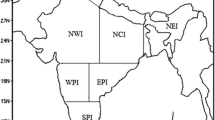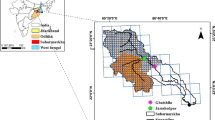Abstract
This study uses a multi-model ensemble (MME) for the assessment of the spatial and temporal variations of rainfall in peninsular Malaysia under climate change scenarios. The past performance approach was used for the selection of GCM ensemble from a pool of Coupled Model Intercomparison Project Phase 5 (CMIP5) GCMs. The performances of four bias correction methods, namely, scaling, gamma quantile mapping, generalized quantile mapping, and power transformation were assessed to select the most suitable method for the downscaling of daily rainfall of selected GCMs based on APHRODITE rainfall at a spatial resolution of 0.25° × 0.25°. The downscaling model was used for the projections of daily rainfall for the period 2010–2099 for four representative concentration pathways (RCP) scenarios, namely, RCP2.6, RCP4.5, RCP6.0, and RCP8.5. Random forest regression algorithm was used to develop the multi-model ensemble (MME) mean of GCM-projected rainfall for different RCPs in order to show the changes in rainfall for three future periods, 2010–2039, 2040–2069, and 2070–2099. The results revealed four GCMs, BCC-CSM1.1(M), CCSM4, CSIRO-Mk3.6.0, and HadGEM2-ES as the most suitable GCMs for the projection of daily rainfall of peninsular Malaysia. The power transformation was found as the most suitable method for the correction of biases in GCM daily rainfall. The MME mean of projected rainfall showed the increase in rainfall in peninsular Malaysia for all the scenarios and future periods. The maximum increase in annual rainfall was projected by 15.72% during 2070–2099 for RCP8.5. The variability of future rainfall was also found to increase along with mean rainfall. The increase in rainfall variability was projected by 26.15% for RCP8.5 during 2070–2099. The spatial pattern of rainfall changes revealed more variability in future rainfall in the northeast where frequency of hydro-climatic disasters is higher compared to other regions. The results indicate the possible increase in hydro-climatic disaster in peninsular Malaysia due to climate change.







Similar content being viewed by others
References
Ahmed K, Shahid S, Haroon SB, Xiao-Jun W (2015a) Multilayer perceptron neural network for downscaling rainfall in arid region: a case study of Baluchistan, Pakistan. J Earth Syst Sci 124:1325–1341
Ahmed K, Shahid S, Harun S, Nawaz N (2015b) Performance assessment of different bias correction methods in statistical downscaling of precipitation. Malays J Civ Eng 27(2):311-324
Ahmed K, Shahid S, Nawaz N, Khan N (2018) Modeling climate change impacts on precipitation in arid regions of Pakistan: a non-local model output statistics downscaling approach. Theor Appl Climatol:1–18. https://doi.org/10.1007/s00704-018-2672-5
Ahmed K, Shahid S, Sachindra DA, Chung ES (2019) Fidelity assessment of general circulation model simulated precipitation and temperature over Pakistan using a feature selection method. J Hydrol 573:281–298. https://doi.org/10.1016/j.jhydrol.2019.03.092
Akinsanola A et al (2018) Evaluation of rainfall simulations over West Africa in dynamically downscaled CMIP5 global circulation models. Theor Appl Climatol 132:437–450
Eden JM, Widmann M (2014) Downscaling of GCM-simulated precipitation using model output statistics. J Clim 27:312–324
Fang G, Yang J, Chen YN, Zammit C (2015) Comparing bias correction methods in downscaling meteorological variables for a hydrologic impact study in an arid a rea in China, Hydrol. Earth Syst Sci 19(6): 2547–2559.
Gaur A, Simonovic SP (2018) Application of physical scaling towards downscaling climate model precipitation data. Theor Appl Climatol 132:287–300
Gebremedhin MA, Abraha AZ, Fenta AA (2018) Changes in future climate indices using Statistical Downscaling Model in the upper Baro basin of Ethiopia. Theor Appl Climatol 133:39–46
Gleckler PJ, Taylor KE, Doutriaux C (2008) Performance metrics for climate models. J Geophys Res: Atmos 113:D06104. https://doi.org/10.1029/2007JD008972
Gudmundsson L, Bremnes J, Haugen J, Engen-Skaugen T (2012) Technical note: downscaling RCM precipitation to the station scale using statistical transformations–a comparison of methods. Hydrol Earth Syst Sci 16:3383–3390
Gutmann ED, Rasmussen RM, Liu C, Ikeda K, Gochis DJ, Clark MP, Dudhia J, Thompson G (2012) A comparison of statistical and dynamical downscaling of winter precipitation over complex terrain. J Clim 25:262–281
Ines AV, Hansen JW (2006) Bias correction of daily GCM rainfall for crop simulation studies. Agric For Meteorol 138:44–53
Ishizaki NN, Dairaku K, Ueno G (2017) Regional probabilistic climate projection for Japan with a regression model using multi-model ensemble experiments. Hydrol Res Lett 11:44–50
Khan N, Shahid S, Ahmed K, Ismail T, Nawaz N, Son M (2018) Performance assessment of general circulation model in simulating daily precipitation and temperature using multiple gridded datasets. Water 10:1793
Khan N, Pour SH, Shahid S, Ismail T, Ahmed K, Chung ES, Nawaz N, Wang XJ (2019) Spatial distribution of secular trends in rainfall indices of peninsular Malaysia in the presence of long-term persistence. Meteorl Appl. https://doi.org/10.1002/met.1792
Kim J, Ivanov VY, Fatichi S (2016) Climate change and uncertainty assessment over a hydroclimatic transect of Michigan. Stoch Env Res Risk A 30:923–944
Lee J-W, Hong S-Y, Chang E-C, Suh M-S, Kang H-S (2014) Assessment of future climate change over East Asia due to the RCP scenarios downscaled by GRIMs-RMP. Clim Dyn 42:733–747
Li H, Sheffield J, Wood EF (2010) Bias correction of monthly precipitation and temperature fields from intergovernmental panel on climate change AR4 models using equidistant quantile matching. J Geophys Res: Atmos 115:D10101. https://doi.org/10.1029/2009JD012882
Lin G-F, Chang M-J, Wu J-T (2017) A hybrid statistical downscaling method based on the classification of rainfall patterns. Water Resour Manag 31:377–401
Lutz AF, ter Maat HW, Biemans H, Shrestha AB, Wester P, Immerzeel WW (2016) Selecting representative climate models for climate change impact studies: an advanced envelope-based selection approach. Int J Climatol 36:3988–4005
Maraun D, Wetterhall F, Ireson AM, Chandler RE, Kendon EJ, Widmann M, Brienen S, Rust HW, Sauter T, Themeßl M, Venema VKC, Chun KP, Goodess CM, Jones RG, Onof C, Vrac M, Thiele-Eich I (2010) Precipitation downscaling under climate change: recent developments to bridge the gap between dynamical models and the end user. Rev Geophys 48:RG3003. https://doi.org/10.1029/2009RG000314
Mayowa OO, Pour SH, Shahid S, Mohsenipour M, Harun SB, Heryansyah A, Ismail T (2015) Trends in rainfall and rainfall-related extremes in the east coast of peninsular Malaysia. J Earth Syst Sci 124:1609–1622
MMD (2009) Climate change scenarios for Malaysia 2001–2090. Malaysian Meteorological Department, Kuala Lumpur
Nashwan M, Shahid S, Chung E-S, Ahmed K, Song Y (2018) Development of climate-based index for hydrologic hazard susceptibility. Sustainability 10:2182
Noor M, Ismail T, Chung E-S, Shahid S, Sung J (2018) Uncertainty in rainfall intensity duration frequency curves of peninsular Malaysia under changing climate scenarios. Water 10:1750
Nourani V, Razzaghzadeh Z, Baghanam AH, Molajou A (2018) ANN-based statistical downscaling of climatic parameters using decision tree predictor screening method. Theor Appl Climatol:1–18. https://doi.org/10.1007/s00704-018-2686-z
Oyerinde GT, Diekkrüger B (2017) Influence of parameter sensitivity and uncertainty on projected runoff in the Upper Niger Basin under a changing climate. Climate 5:67
Pierce DW, Barnett TP, Santer BD, Gleckler PJ (2009a) Selecting global climate models for regional climate change studies. Proc Natl Acad Sci 106:8441–8446
Pierce DW, Barnett TP, Santer BD, Gleckler PJ (2009b) Selecting global climate models for regional climate change studies. Proceedings of the National Academy of Sciences:pnas. 0900094106
Pour SH, Harun SB, Shahid S (2014) Genetic programming for the downscaling of extreme rainfall events on the East Coast of peninsular Malaysia. Atmosphere 5:914–936
Pour SH, Shahid S, Chung E-S, Wang X-J (2018) Model output statistics downscaling using support vector machine for the projection of spatial and temporal changes in rainfall of Bangladesh. Atmos Res 213:149–162
Raju KS, Sonali P, Kumar DN (2017) Ranking of CMIP5-based global climate models for India using compromise programming. Theor Appl Climatol 128:563–574
Rashid MM, Beecham S, Chowdhury RK (2017) Simulation of extreme rainfall and projection of future changes using the GLIMCLIM model. Theor Appl Climatol 130:453–466
Reichler T, Kim J (2008) How well do coupled models simulate today's climate? Bull Am Meteorol Soc 89:303–312
Rupp DE, Abatzoglou JT, Hegewisch KC, Mote PW (2013) Evaluation of CMIP5 20th century climate simulations for the Pacific Northwest USA. J Geophys Res: Atmos 118:10,884–810,906
Sa'adi Z, Shahid S, Chung E-S, bin Ismail T (2017) Projection of spatial and temporal changes of rainfall in Sarawak of Borneo Island using statistical downscaling of CMIP5 models. Atmos Res 197:446–460
Sachindra D, Perera B (2016) Statistical downscaling of general circulation model outputs to precipitation accounting for non-stationarities in predictor-predictand relationships. PLoS One 11:e0168701
Sachindra D, Huang F, Barton A, Perera B (2014) Statistical downscaling of general circulation model outputs to precipitation—part 2: bias-correction and future projections. Int J Climatol 34:3282–3303
Sachindra DA, Ahmed K, Shahid S, Perera JC (2018a) Cautionary note on the use of genetic programming in statistical downscaling. Int J Climatol 38(8):3449–3465. https://doi.org/10.1002/joc.5508
Sachindra DA, Ahmed K, Rashid MM, Shahid S, Perera BJC (2018b) Statistical downscaling of precipitation using machine learning techniques. Atmos Res 212:240–258
Salem GSA, Kazama S, Shahid S, Dey NC (2018) Impacts of climate change on groundwater level and irrigation cost in a groundwater dependent irrigated region. Agric Water Manag 208:33–42
Salman SA, Shahid S, Ismail T, Ahmed K, Wang X-J (2018) Selection of climate models for projection of spatiotemporal changes in temperature of Iraq with uncertainties. Atmos Res 213:509–522
Samadi S, Sagareswar G, Tajiki M (2010) Comparison of general circulation models: methodology for selecting the best GCM in Kermanshah Synoptic Station, Iran. Int J Glob Warming 2:347–365
Scherer M, Diffenbaugh NS (2014) Transient twenty-first century changes in daily-scale temperature extremes in the United States. Clim Dyn 42:1383–1404
Shahid S, Alamgir M, Wang X-j, Eslamian S (2017a) Climate change impacts on and adaptation to groundwater. In: Handbook of Drought and Water Scarcity. CRC Press, Boca Raton, pp 121–138
Shahid S, Pour SH, Wang X, Shourav SA, Minhans A, Tb I (2017b) Impacts and adaptation to climate change in Malaysian real estate. Int J Clim Change Strategies Manage 9:87–103
Sharma D, Gupta AD, Babel M (2007) Spatial disaggregation of bias-corrected GCM precipitation for improved hydrologic simulation: Ping River Basin, Thailand. Hydrol Earth Syst Sci Discuss 11:1373–1390
Shiru MS, Shahid S, Chung ES, Alias N, Scherer L (2019) A MCDM-based framework for selection of general circulation models and projection of spatio-temporal rainfall changes: a case study of Nigeria. Atmos Res 225:1–16. https://doi.org/10.1016/j.atmosres.2019.03.033
Steinschneider S, McCrary R, Mearns LO, Brown C (2015) The effects of climate model similarity on probabilistic climate projections and the implications for local, risk-based adaptation planning. Geophys Res Lett 42:5014–5044
Turco M, Llasat MC, Herrera S, Gutiérrez JM (2017) Bias correction and downscaling of future RCM precipitation projections using a MOS-analog technique. J Geophys Res: Atmos 122:2631–2648
Widmann M, Bretherton CS, Salathé EP Jr (2003) Statistical precipitation downscaling over the northwestern United States using numerically simulated precipitation as a predictor. J Clim 16:799–816
Wilby RL, Wigley T (1997) Downscaling general circulation model output: a review of methods and limitations. Prog Phys Geogr 21:530–548
Wong CL, Liew J, Yusop Z, Ismail T, Venneker R, Uhlenbrook S (2016) Rainfall characteristics and regionalization in peninsular Malaysia based on a high resolution gridded data set. Water 8:500
Yatagai A, Arakawa O, Kamiguchi K, Kawamoto H, Nodzu MI, Hamada A (2009) A 44-year daily gridded precipitation dataset for Asia based on a dense network of rain gauges. Sola 5:137–140
You Q, Jiang Z, Wang D, Pepin N, Kang S (2018) Simulation of temperature extremes in the Tibetan Plateau from CMIP5 models and comparison with gridded observations. Clim Dyn 51:355–369
Zhang X, Xiong Z, Zheng J, Ge Q (2018) High-resolution precipitation data derived from dynamical downscaling using the WRF model for the Heihe River Basin, northwest China. Theor Appl Climatol 131:1249–1259
Zhou B, Wen QH, Xu Y, Song L, Zhang X (2014) Projected changes in temperature and precipitation extremes in China by the CMIP5 multimodel ensembles. J Clim 27:6591–6611
Funding
The study is supported by the Universiti Teknologi Malaysia through Research University Grant (RUG) no. 18H94.
Author information
Authors and Affiliations
Corresponding author
Additional information
Publisher’s note
Springer Nature remains neutral with regard to jurisdictional claims in published maps and institutional affiliations.
Rights and permissions
About this article
Cite this article
Noor, M., Ismail, T.b., Shahid, S. et al. Selection of CMIP5 multi-model ensemble for the projection of spatial and temporal variability of rainfall in peninsular Malaysia. Theor Appl Climatol 138, 999–1012 (2019). https://doi.org/10.1007/s00704-019-02874-0
Received:
Accepted:
Published:
Issue Date:
DOI: https://doi.org/10.1007/s00704-019-02874-0




